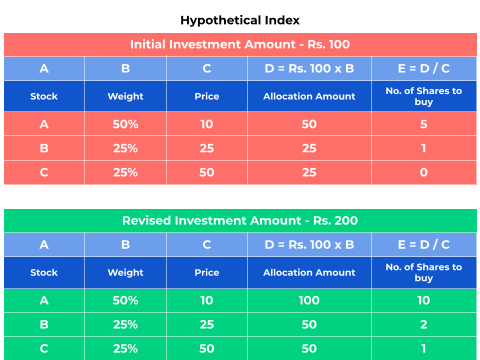Investor can buy or sell ETF units on the stock exchanges in multiple of 1 unit. However, in case if any investor wants to buy or sell ETF units, directly with AMCs / Fund House, the minimum application size is mentioned in “Creation Size”

To efficiently track the underlying index, ETF scheme has to buy basket of stocks in same proportion as defined by that index.
Suppose, investor wants to invest Rs. 100 in an ETF.
This ETF is tracking an index which has three stocks. Stock A has weight of 50%, Stock B has weight of 25% and stock C has weight of 25%.
In such case, Rs. 50 will be allocated to stock A, Rs. 25 to stock B and Rs. 25 to stock C.
Now suppose, market price of stock A is Rs. 10, stock B is Rs. 25 and stock C is Rs. 50. In such case this ETF scheme will buy, 5 shares of stock A (Rs. 50 ÷ Rs. 10 per share), 1 share of stock B (Rs. 25 ÷ Rs. 25 per share) but buying of stock C will not be possible as Rs. 25 has to be allocated to stock C and the price is Rs. 50.
In such case ETF scheme will increase the minimum investment amount to Rs. 200 so it can buy at least 1 share of stock C.
In this example, if investor wants to transact directly with AMC / Fund House, s/he has to do transactions in multiple of Rs. 200. Further, if NAV of this ETF is Rs. 25 per share, the unit creation size will be 8 units (Rs. 200 of investment amount ÷ NAV of Rs. 25 per share).
In other words, if investor wants to directly transact with ETF manufacturer, instead of buying or selling ETF units on secondary market of stock exchange, it has to be in multiple of “Unit Creation Size” of 8 units per lot.
Normally, Unit Creation Size is defined by the AMCs at the time of launching. Even if AMC has the discretion to change the size as and when required, it is not revised frequently.
Investors buying or selling ETF units on stock exchanges need NOT to worry about unit creation size, as on exchanges they can trade in multiple of 1 unit.
Source: http://passivefunds.in/index-funds-etfs/